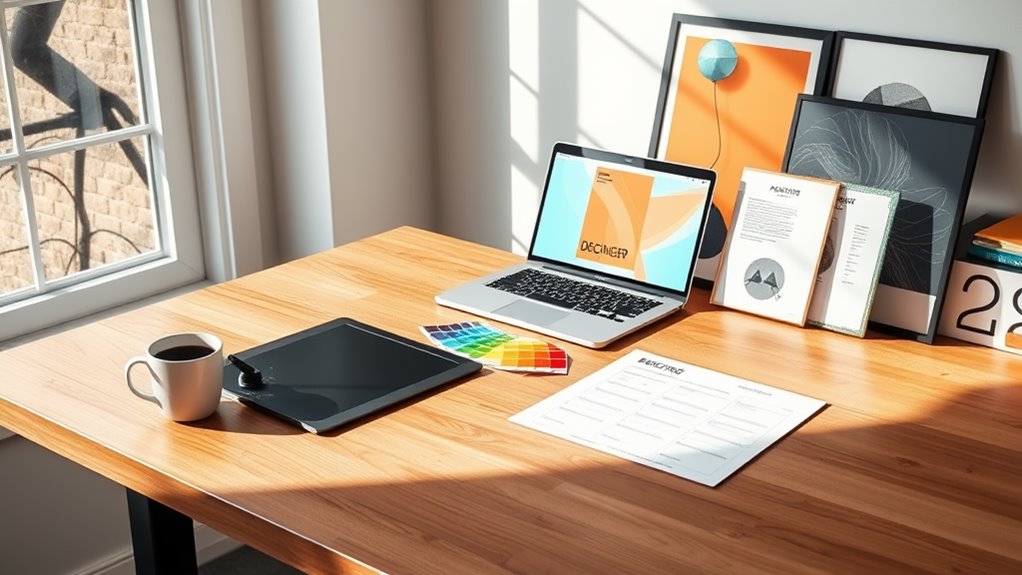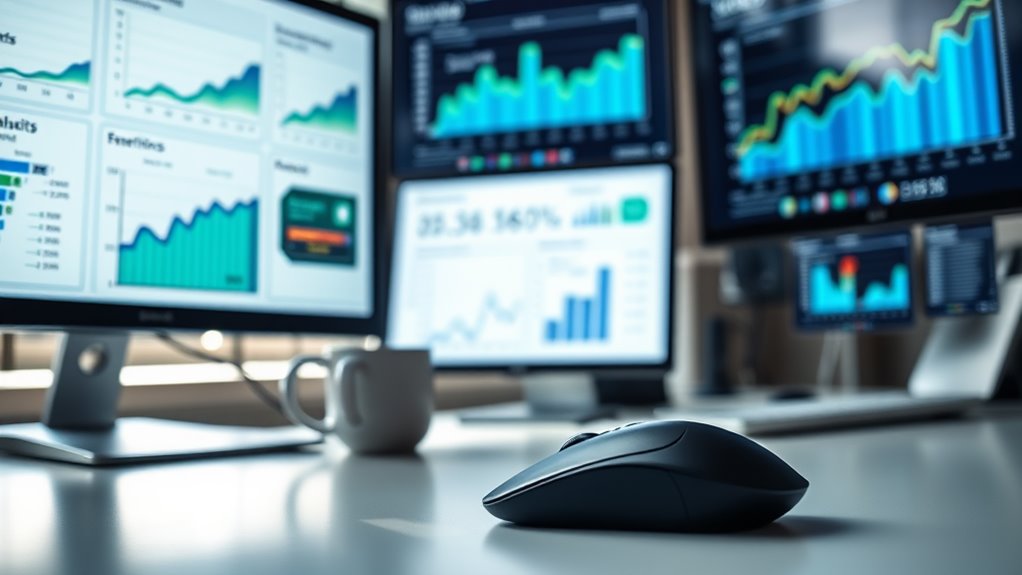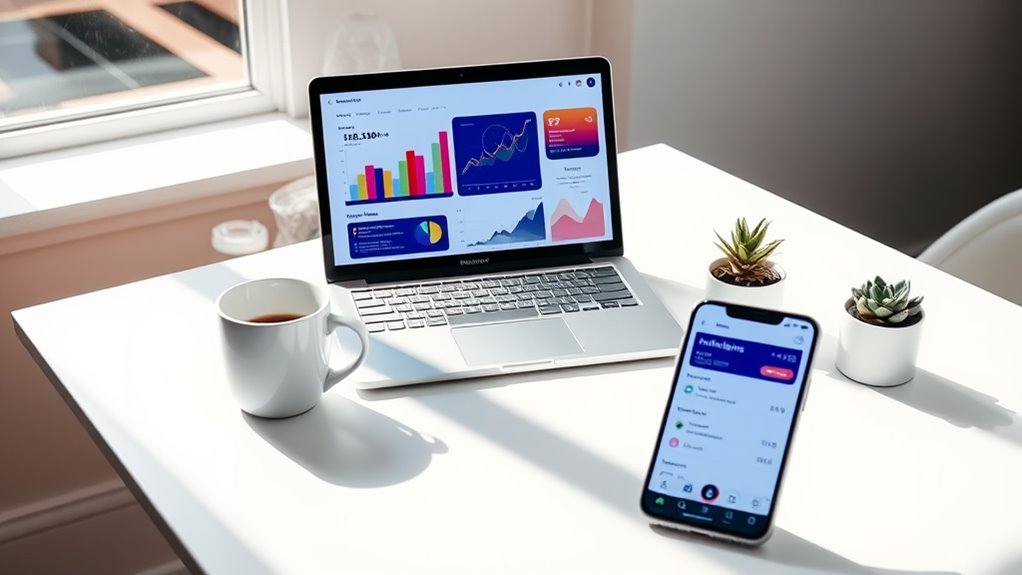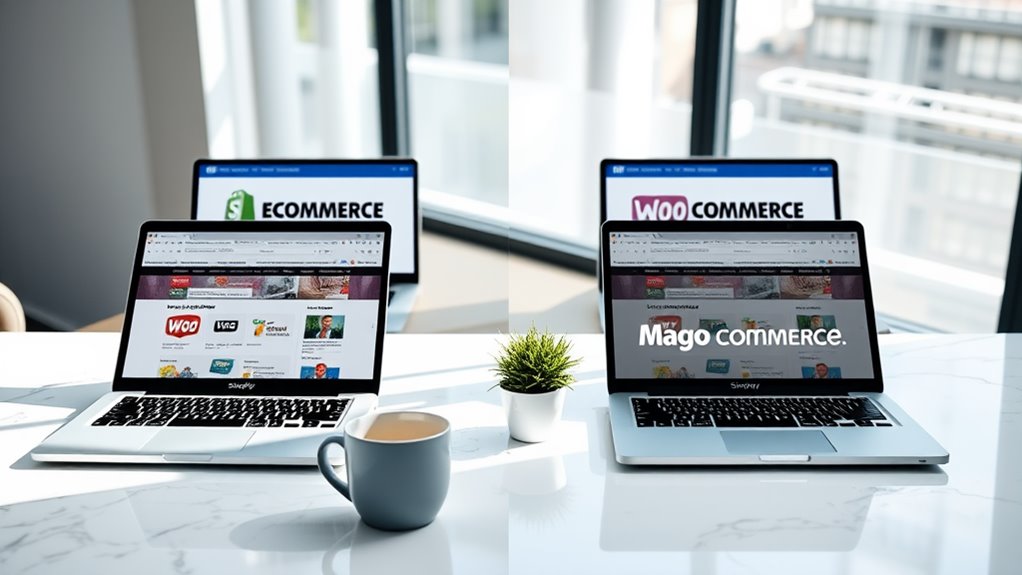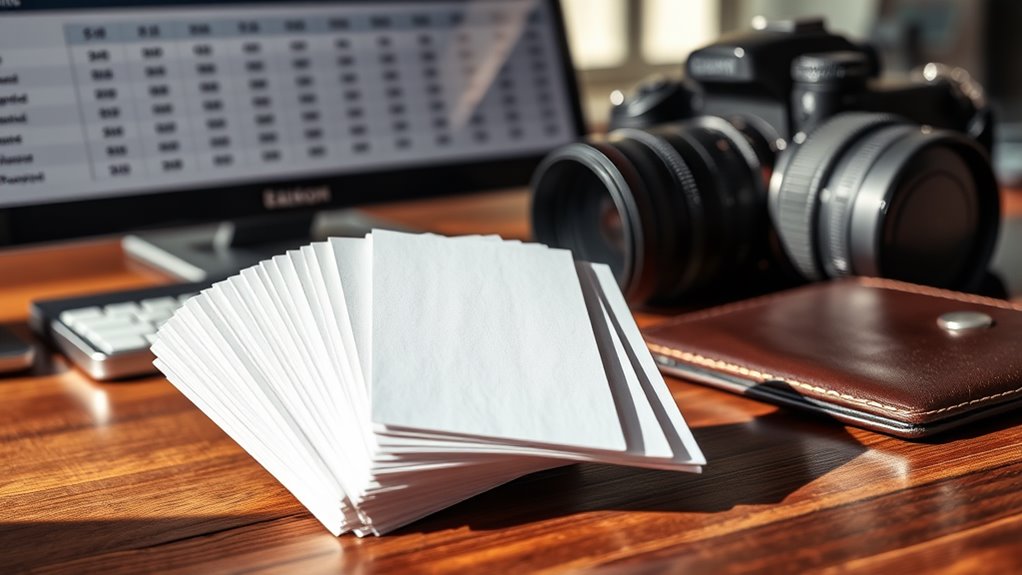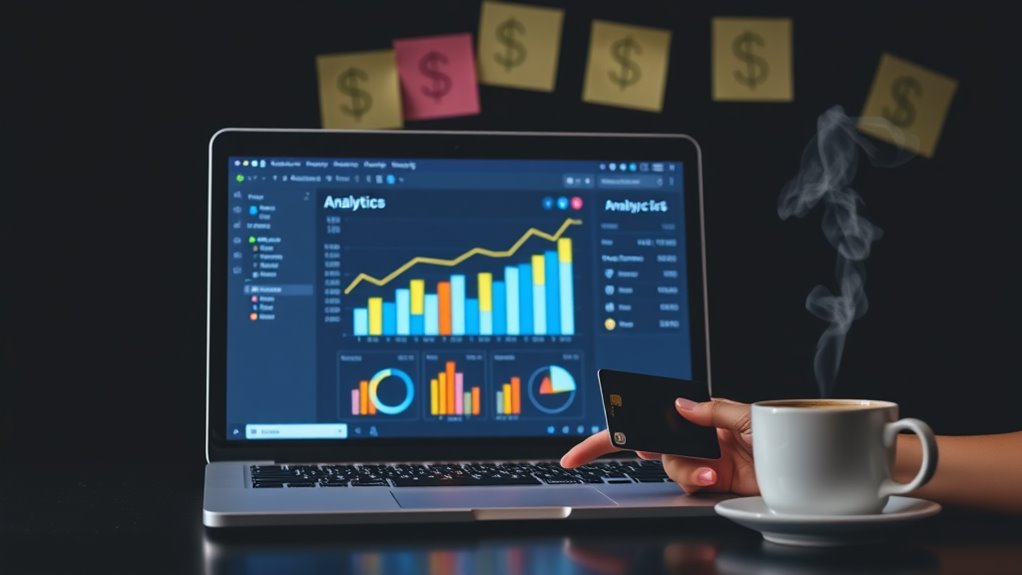Your poster design pricing should align with your experience level and project complexity. Entry-level designers typically charge $25-75 per poster, mid-range designers command $150-350, and expert designers can charge $500-1,500+. You'll need to factor in your operating costs, desired income, and billable hours to establish a base rate, then adjust for scope factors like multiple variations (+25-35%), advanced illustration (+40-75%), or complex typography (+30-50%). Consider your client type too – local businesses usually budget $150-500, while corporate clients expect to invest $2,000+. These fundamentals will help you develop a sustainable pricing strategy that matches your expertise and market position.
Key Takeaway
- Basic poster designs typically range from $150-350, with premium designs reaching $500-1,500+ based on complexity and experience level.
- Calculate your minimum hourly rate by dividing annual target income plus expenses by expected billable hours (typically 1,000-1,200).
- Add 25-35% for multiple design variations, 40-75% for advanced illustrations, and 30-50% for complex typography or photo manipulation.
- Consider client type when pricing: local businesses ($150-500), mid-sized companies ($500-2,000), and corporate clients ($2,000+).
- Factor in usage rights, geographic location, and project deliverables when determining final poster design rates.
Market Research and Industry Standards
Looking into current market rates and industry standards provides essential baseline information for setting your poster design prices. You'll find that rates typically fall into distinct tiers based on market positioning and designer experience level.
Current Market Ranges:
- Entry-level: $25-75 per poster design
- Mid-range: $150-350 per poster design
- Premium/Expert: $500-1,500+ per poster design
Key Factors Affecting Industry Standards:
- Geographic location (metropolitan areas command higher rates)
- Project complexity and timeline
- Usage rights and licensing requirements
- Client's industry and budget size
To determine your best pricing:
- Survey local design agencies and freelancers in your area
- Check online platforms like Upwork and Fiverr for current rates
- Review professional design associations' pricing guides
- Analyze competitor portfolios and their price points
Remember that 72% of successful designers regularly adjust their rates based on market research. You'll want to reassess your pricing structure every 6-12 months to stay competitive while maintaining profitability. Consider offering tiered packages that align with different market segments and client needs.
Calculating Your Base Design Rate
To establish a sustainable pricing structure, you'll need to calculate your base design rate by factoring in your operating costs, desired income, and available working hours. Start by determining your annual expenses and target salary, then divide by your actual billable hours to find your minimum hourly rate.
Essential Cost Factors to Evaluate:
- Business overhead (software, equipment, workspace)
- Professional development and training
- Healthcare and benefits
- Taxes and insurance
- Marketing and advertising expenses
Working Hours Calculation:
- Start with 52 weeks × 40 hours = 2,080 potential hours
- Subtract time for:
- Administrative tasks (20%)
- Marketing and client acquisition (15%)
- Holidays and vacation (4 weeks)
- Sick days and personal time (1 week)
Your actual billable hours will likely be between 1,000-1,200 annually. For example, if you're targeting $75,000 annually with $15,000 in expenses, and you have 1,100 billable hours, your minimum hourly rate should be ($90,000 ÷ 1,100) = $82 per hour. This rate serves as your foundation for project-based pricing and package offerings.
Project Scope and Complexity
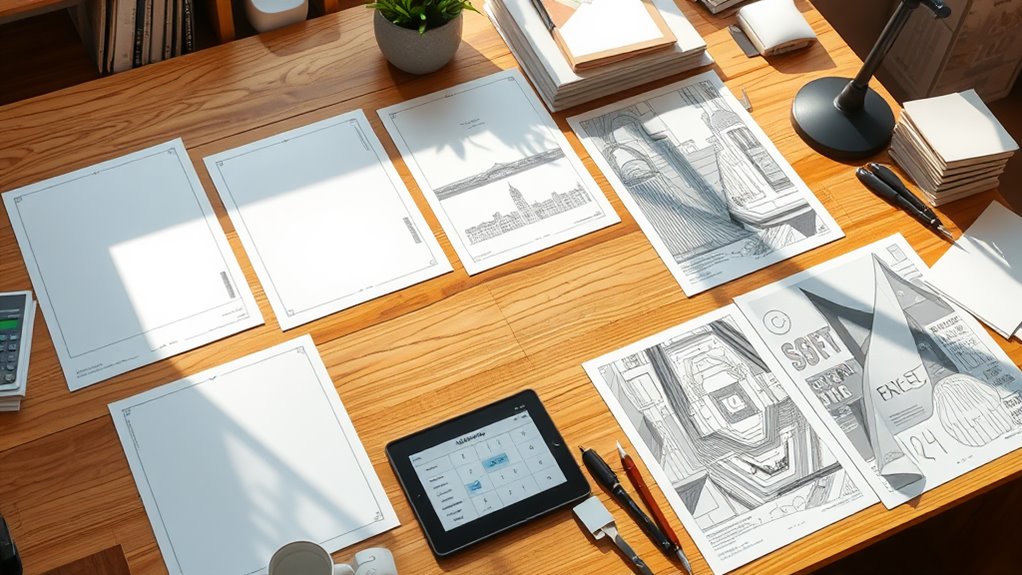
Beyond your base rate, a poster design's scope and complexity greatly impact its final price. You'll need to review several key factors, including the number of design iterations, technical requirements, and specialized elements that your client requests.
Consider these complexity factors that warrant higher pricing:
- Multiple design variations required (each variation typically adds 25-35% to the base price)
- Advanced illustration work or custom artwork creation (can increase project cost by 40-75%)
- Complex typography treatments or detailed photo manipulation (usually adds 30-50% to base rate)
When evaluating project scope, you'll want to analyze the deliverables carefully. For instance, if your client needs both print and digital versions, you should factor in the additional time for creating multiple file formats and specifications. Similarly, projects requiring extensive research or competitor analysis will demand more of your expertise and time.
Technical considerations also play a significant role. You'll need to account for specialized printing requirements, color matching systems, or high-resolution imagery that might require additional sourcing or manipulation time.
Experience Level and Portfolio
Your professional experience and portfolio strength directly influence your poster design rates. As you gain expertise and build a more impressive body of work, you'll be able to command higher fees for your services.
Experience Level Pricing Guidelines:
- Entry-level (0-2 years): $25-50 per poster
- Mid-level (3-5 years): $50-150 per poster
- Expert-level (6+ years): $150-500+ per poster
Portfolio Considerations:
- Quality of previous poster designs
- Industry-specific experience
- Awards and recognition
- Client testimonials
- Brand collaborations
You'll want to regularly assess your position within these ranges by evaluating your:
- Technical proficiency with design software
- Understanding of current design trends
- Success rate with past projects
- Ability to meet deadlines
- Problem-solving capabilities
Remember to document your growth through case studies and maintain an up-to-date portfolio that showcases your best work. When you're able to demonstrate consistent results and specialized expertise, you can justify incrementally increasing your rates to match your developing skill set.
Client Type and Budget
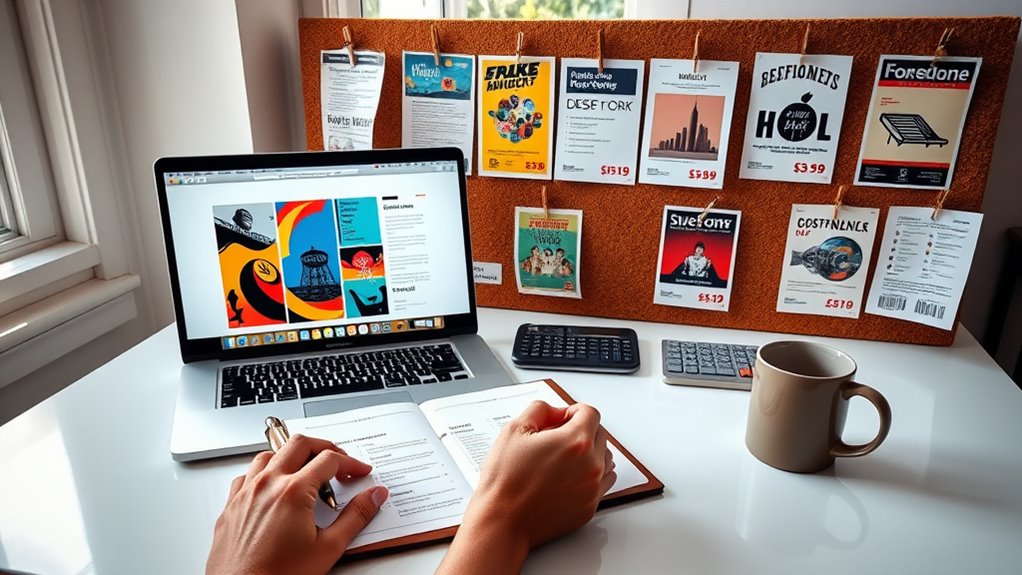
Different client types come with varying budget expectations and constraints, which greatly affects how you'll price your poster design services. When working with startups or small businesses, you'll typically find budgets ranging from $200-800, while larger corporations might allocate $1,000-5,000 for a single poster design.
Consider these key client segments and their typical budget ranges:
- Local businesses and non-profits ($150-500): They're often budget-conscious but value community connection, making it essential to offer scaled-down packages that maintain quality.
- Mid-sized companies ($500-2,000): They'll invest in professional design but require clear ROI justification, so you'll need to demonstrate value through metrics and case studies.
- Corporate clients ($2,000+): They expect premium service and multiple revisions, which justifies higher rates that reflect the complexity of their requirements.
You'll need to adjust your pricing strategy based on the client's industry, size, and location. For instance, tech companies in major cities typically have 30% higher budgets than retail businesses in smaller markets. Consider creating tiered pricing packages that align with these different market segments.
Value-Based Pricing Strategies
Value-based pricing represents a strategic shift away from hourly rates, focusing instead on the tangible impact your poster design will have on the client's business objectives. When implementing this approach, you'll need to evaluate several key factors that determine your design's worth.
Key Value Indicators to Ponder:
- Expected event attendance or exposure
- Potential revenue generation from the poster
- Brand visibility and market reach
- Usage rights and distribution scope
- Competition differentiation value
To calculate your value-based price:
- Assess the client's projected ROI from the poster
- Determine the poster's lifetime usage
- Factor in any exclusive rights or special applications
- Reflect on market positioning impact
For example, if your poster design will promote a conference expecting 5,000 attendees with tickets at $200 each, you might charge 3-5% of the projected revenue. Similarly, a poster for a national retail campaign that'll be displayed in 500 locations warrants higher pricing due to its extensive reach and impact.
Remember to document these value metrics when presenting your price to clients, as they'll help justify your rates through concrete business outcomes.
Conclusion
Just as a master chef adjusts recipes based on ingredients and clientele, you'll need to fine-tune your poster design rates based on multiple factors. You're now equipped with the tools to calculate your worth – from market research to value-based pricing. Start with industry benchmarks ($50-150/hour for most designers), then adjust based on your expertise, project complexity, and client's budget. Remember: it's better to raise your rates gradually than undervalue your creative work.

